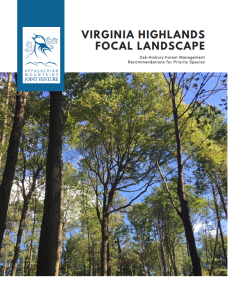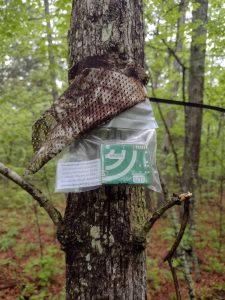
Virginia Highlands Focal Landscape
The Virginia Highlands focal landscape covers portions of 13 counties in northwestern Virginia characterized by forested ridges alternating with valleys dominated by pastures and working farms. The region offers valuable habitat for AMJV priority species such the Cerulean Warbler.
The focal landscape contains a diversity of habitats, including spruce fir forests, mixed hardwood and conifer forests, young forests, old fields, karst habitats, non-tidal wetlands, and warm and cold water streams and riparian habitats. The Virginia Natural Heritage Program designates the majority of the focal landscape as having a high density of conservation sites, which are key areas of the landscape worthy of protection and stewardship because of the rare plants and animals, significant natural communities, and geological features they support. Of the 121 Species of Greatest Conservation Need in Virginia’s Wildlife Action Plan, at least 97 are dependent upon habitats provided within the focal landscape.
In March 2019, AMJV initiated the process of designating a focal landscape in Virginia to help direct and concentrate our work in the state. Through a process that included consultation with numerous state and federal agency and non-profit partners and the review of their existing spatial data and designated priority areas, the Virginia Highlands was identified as the region with the highest potential for establishing a focal landscape. Criteria that were taken into consideration included established partners already working in the region, importance to priority bird species, a mix of public and private lands, and the extent and condition of remaining forest cover. Over the next three months, AMJV facilitated two stakeholder meetings with partners working in the region, which resulted in a finalized boundary of the focal landscape encompassing 2.2 million acres.
As part of the stakeholder planning process, local partners identified priority habitats and associated species for conservation action in the Virginia Highlands.
 Partners in this region also identified a need for assistance with landscape-level planning and comprehensive stand-level forest management recommendations. To fill this need, AMJV led focal landscape partners in the development of Oak-Hickory Forest Management Recommendations for the VA Highlands Focal Landscape. The guide is written following an approach called Full Rotation Conservation Planning.
Partners in this region also identified a need for assistance with landscape-level planning and comprehensive stand-level forest management recommendations. To fill this need, AMJV led focal landscape partners in the development of Oak-Hickory Forest Management Recommendations for the VA Highlands Focal Landscape. The guide is written following an approach called Full Rotation Conservation Planning.
This approach offers management guidance at both the landscape and stand level for a suite of multiple priority species, helping to create high-quality habitat throughout all forest ages.
In 2020, the AMJV Partnership received an award from the National Fish and Wildlife Foundation’s Central Appalachia Habitat Stewardship Program that launched our on-the-ground planning, management, and monitoring in the focal landscape. The objective of this project is to increase age-class and structural diversity to benefit golden-winged warbler, cerulean warbler and wood thrush by building a coalition of partners and landowners, identifying and addressing planning needs, initiating implementation of forest management activities, and enhancing capacity for future management. Project activities include the development of dynamic forest management plans for 5,100 acres of public and private lands, and initial implementation of forest management activities on 130 acres. To build capacity for forest management planning aimed at improving wildlife habitat, the project includes the development of best management practice guidance materials and an associated training workshop to increase the number of foresters available to write forest management plans that include enhancing wildlife habitat. Partners supporting this project include Virginia Dept. of Wildlife Resources, University of Maryland Center for Environmental Science Appalachian Laboratory, National Wild Turkey Federation, The Nature Conservancy in Virginia, Alliance for the Chesapeake Bay, Virginia Natural Resources Conservation Service, and the US Forest Service.

An autonomous recording unit installed at a project site in the focal landscape.
As we make progress toward our goal of increasing management for age-class and structural diversity within the focal landscape, AMJV is working to track the impacts of this management on our priority species. In the Virginia Highlands focal landscape, this work is being led by Dr. Emily Cohen (University of Maryland Center for Environmental Science, Appalachian Laboratory). Over two field seasons in 2021 and 2022, Dr. Cohen and her students used autonomous recording units (ARUs) and point counts to monitor bird populations within the focal landscape. Data collected will provide baseline information on bird populations within the focal landscape that will help to track the impacts of increased management within the focal landscape over time.
Virginia Department of Wildlife Resources is the lead partner for this focal landscape. Other partners include:
Valley Conservation Council
Virginia Department of Forestry
Virginia Department of Conservation and Recreation, Natural Heritage
Mountain Soil and Water Conservation District
Virginia Natural Resources Conservation Service
The Nature Conservancy
National Wild Turkey Federation
US Forest Service
Virginia Outdoors Foundation
University of Maryland Center for Environmental Science, Appalachian Lab
Northern Institute of Applied Climate Science
Second Season of Bird Monitoring Completed (Winter 2022)
Partner Spotlight: The Nature Conservancy’s Allegheny Highlands Program (Summer 2022)
Landowner Highlight: Boiling Springs Rod and Gun Club (Summer 2022)